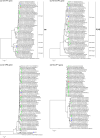Full genome characterization of a Kenyan G8P[14] rotavirus strain suggests artiodactyl-to-human zoonotic transmission
- PMID: 40524227
- PMCID: PMC12168323
- DOI: 10.1186/s41182-025-00759-9
Full genome characterization of a Kenyan G8P[14] rotavirus strain suggests artiodactyl-to-human zoonotic transmission
Abstract
Background: Rotavirus infections are a major cause of severe gastroenteritis in children. Human rotavirus strains with the unconventional G8P[14] genotype have sporadically been detected in diarrheic patients in different parts of the world. However, full genomes of only two human G8P[14] strains from Africa (North Africa) have been sequenced, and the origin and evolutionary patterns of African G8P[14] strains remain to be elucidated.
Methods: In this study, we sequenced the full genome of an African G8P[14] strain (RVA/Human-wt/KEN/A75/2000/G8P[14]) identified in archival stool samples from a diarrheic child in Kenya.
Results: Full genome-based analysis of strain A75 revealed a unique genogroup constellation, G8-P[14]-I2-R2-C2-M2-A11-N2-T6-E2-H3, with the I2-R2-C2-M2-A11-N2-T6-E2-H3 part being common among rotavirus strains from artiodactyls such as cattle. Phylogenetic analysis showed that all the 11 genomic segments of strain A75 are closely related to segments found in artiodactyl rotavirus strains, and likely strain A75 derived from spillover transmission of an artiodactyl rotavirus strain to humans.
Conclusion: This is the first report on a full genome-based characterization of a human G8P[14] strain from East Africa. This study demonstrates the diversity of human G8P[14] strains in Africa and contributes to the elucidation of their spreading and evolution, which includes zoonotic transmission from artiodactyls.
Keywords: Africa; Artiodactyls; Full genome-based analysis; G8P[14] strains; Group A rotavirus; Interspecies transmission; Kenya.
© 2025. The Author(s).
Conflict of interest statement
Declarations. Ethics approval and consent to participate: Ethical approval for this study was obtained from the Scientific and Ethical Review Committees of the Kenya Medical Research Institute (KEMRI). Consent for publication: Not applicable. Competing interests: The authors declare no competing interests.
Figures




Similar articles
-
Full genomic analysis of a G8P[1] rotavirus strain isolated from an asymptomatic infant in Kenya provides evidence for an artiodactyl-to-human interspecies transmission event.J Med Virol. 2011 Feb;83(2):367-76. doi: 10.1002/jmv.21974. J Med Virol. 2011. PMID: 21181935
-
Full-length genome analysis of the first human G8P[14] rotavirus strain from Morocco suggests evidence of zoonotic transmission.Virus Genes. 2019 Aug;55(4):465-478. doi: 10.1007/s11262-019-01677-9. Epub 2019 Jun 13. Virus Genes. 2019. PMID: 31197545
-
Novel NSP1 genotype characterised in an African camel G8P[11] rotavirus strain.Infect Genet Evol. 2014 Jan;21:58-66. doi: 10.1016/j.meegid.2013.10.002. Epub 2013 Oct 30. Infect Genet Evol. 2014. PMID: 24184096
-
Whole genome analyses of African G2, G8, G9, and G12 rotavirus strains using sequence-independent amplification and 454® pyrosequencing.J Med Virol. 2011 Nov;83(11):2018-42. doi: 10.1002/jmv.22207. J Med Virol. 2011. PMID: 21915879
-
Whole genomic analysis of human and bovine G8P[1] rotavirus strains isolated in Nigeria provides evidence for direct bovine-to-human interspecies transmission.Infect Genet Evol. 2016 Sep;43:424-33. doi: 10.1016/j.meegid.2016.06.023. Epub 2016 Jun 11. Infect Genet Evol. 2016. PMID: 27302094
References
-
- Troeger C, Khalil IA, Rao PC, Cao S, Blacker BF, Ahmed T, Armah G, Bines JE, Brewer TG, Colombara DV, Kang G, Kirkpatrick BD, Kirkwood CD, Mwenda JM, Parashar UD, Petri WA Jr, Riddle MS, Steele AD, Thompson RL, Walson JL, Sanders JW, Mokdad AH, Murray CJL, Hay SI, Reiner RC Jr. Rotavirus vaccination and the global burden of rotavirus diarrhea among children younger than 5 years. JAMA Pediatr. 2018;172:958–65. - PMC - PubMed
-
- Ndze VN, Esona MD, Achidi EA, Gonsu KH, Dóró R, Marton S, Farkas S, Ngeng MB, Ngu AF, Obama-Abena MT, Bányai K. Full genome characterization of human rotavirus A strains isolated in Cameroon, 2010–2011: diverse combinations of the G and P genes and lack of reassortment of the backbone genes. Infect Genet Evol. 2014;28:537–60. - PubMed
-
- Sanchez-Padilla E, Grais RF, Guerin PJ, Steele AD, Burny ME, Luquero FJ. Burden of disease and circulating serotypes of rotavirus infection in sub-Saharan Africa: systematic review and meta-analysis. Lancet Infect Dis. 2009;9:567–76. - PubMed
Grants and funding
LinkOut - more resources
Full Text Sources
Miscellaneous
